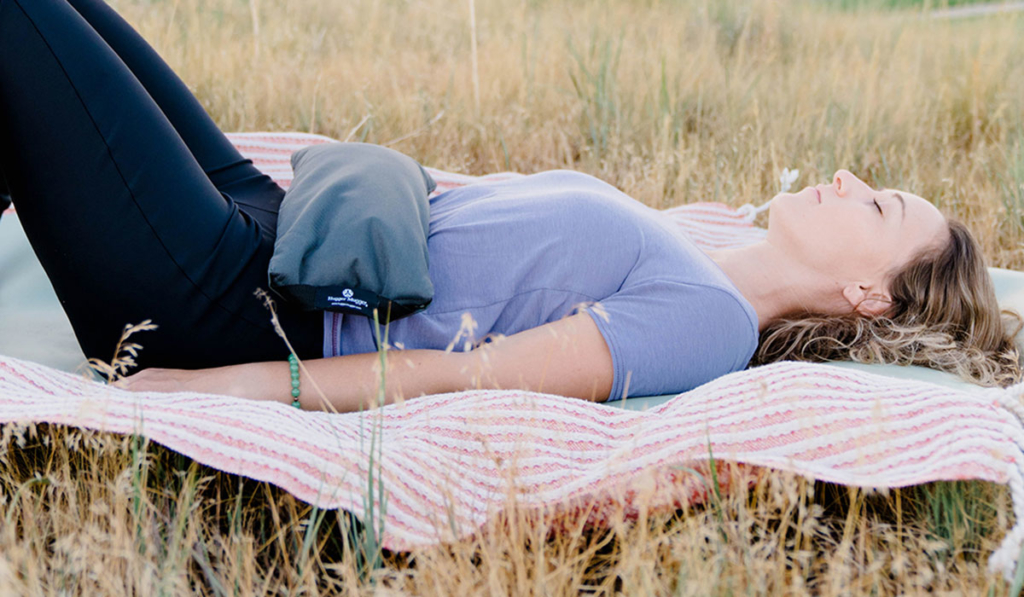
Yoga first became popular in the U.S. in the 1960s. While I was not privy to the practice back then, several friends did practice during that first wave. Judith Hanson Lasater says that when she first began practicing yoga back in the day, the rhythm of classes was quite different, especially from what’s popular these days. She says that after each formal asana, students would lie down for Savasana (Relaxation Pose) for a minute or so. It was a way of letting go of the previous pose. I’ve taken this instruction to heart. But I’ve modified it a bit, to make it a way to practice yoga’s fourth niyama: svadhyaya.
Svadhyaya means two things: self-study and study of sacred wisdom. In asana and meditation practice, we practice svadhyaya when we pay attention to body/mind sensations in each moment’s experience. This is especially true when we practice mindfulness meditation. In fact, it is the essence of that practice. Aligning awareness with what is arising in each moment allows us to make choices based on what is currently true, rather than on some rigid idea that may or may not actually be accurate. Being mindful—practicing svadhyaya—helps us understand why we do what we do.
The Wisdom of Balancing Inspiration
The other side of svadhyaya is the study of inspiring wisdom. Teachers who have walked the path before us can help us see what’s true from a different angle. While self-study is essential in yoga practice, if that’s all we do, it’s easy to get stuck in our own perspectives. Reading books, listening to dharma talks, taking classes and workshops from experienced yoga teachers—all these can help us widen our perspective.
Both self-study and study of sacred wisdom are necessary for a balanced understanding. Self-study gives us a firsthand understanding of how our own bodies and minds work. Finding inspiration from outside ourselves stretches us to see our practices and our lives with fresh eyes. But yoga and meditation are, first and foremost, practices. The self-study aspect of svadhyaya helps us apply the wisdom we absorb from elsewhere to our own lives.
Svadhyaya on the Yoga Mat
We can practice svadhyaya on our yoga mats by turning awareness inward to arising sensations in the body/mind. But we can also take a page from the yoga practice of the 1960s. While the idea of practicing supine Savasana between each pose is intriguing, I’ve modified this to make the transitions a little smoother.
Here’s how it works. For example, if you’re practicing standing poses such as Virabhadrasana (Warrior Pose) or Trikonasana (Triangle Pose), take 30 seconds or more in a neutral pose before moving to your next Warrior or Triangle. I like to practice Utkata Konasana (Goddess Pose) in between wide-legged standing poses. But I practice a relaxed version of it. With my feet parallel, I bend my knees and settle into my feet and legs, and place my hands in Anjali Mudra (Prayer Position). Here, I simply feel what’s arising. This pause allows me to feel the residue left by each pose.
In standing balance poses, I’ll pause in Tadasana (Mountain Pose) between balancing poses. When I practice supine poses, I’ll pause in Constructive Rest Position. And when I’m practicing seated poses, I’ll take a “mini-Savasana” in Dandasana (Staff Pose) or Sukhasana (Seated Cross-Legged Pose). In each of these cases, I’m allowing the more challenging poses to integrate a bit and learning from whatever aftereffects they leave in my body and mind.
As you settle into these neutral poses in between the more challenging poses, ask yourself some questions. For example, is one area of the body warmer/cooler than the rest? Are there areas that feel longer/shorter? More or less tense of contracted? More or less relaxed? Do you feel more grounded? More energetic? How’s your breathing? Has it changed? Do the two sides of your body feel different from each other? I find this exploration especially helpful after practicing the first side of an asymmetrical pose.
Practicing Svadhyaya
If Vinyasa is your cup of tea, this way of practicing will be out of the norm. But you don’t have to practice this way every time you step onto your yoga mat. I pretty much always practice this way because I prefer a slower-paced, more meditative type of asana practice. But even if you love a fast-paced vinyasa, once in a while, check in with yourself between poses.
If you want to practice svahyaya off the mat, for the self-study side of it, try mindfulness. For the wisdom side of it, try reading an array of yogic wisdom such as The Bhagavad Gita or the Yoga Sutras. If you want to dig deep into the yoga tradition, check out Yoga: Immortality and Freedom by Mircea Eliade. For asana wisdom, I love these authors: Donna Farhi, Judith Hanson Lasater, Stephen Cope and Donald Moyer. For meditation, I love books by Joseph Goldstein, Jack Kornfield, Tara Brach, Sharon Salzberg and of course, Thich Nhat Hanh.
Find what resources resonate for you. You don’t have to take everything you read as gospel. The self-study aspect of svadhyaya will help you sort out what is meaningful for you. Developing wisdom is a lifelong process. When we practice svadhyaya, we develop a balanced wisdom that draws on the insights of ourselves and others, and allows us to integrate those insights into our lives.
